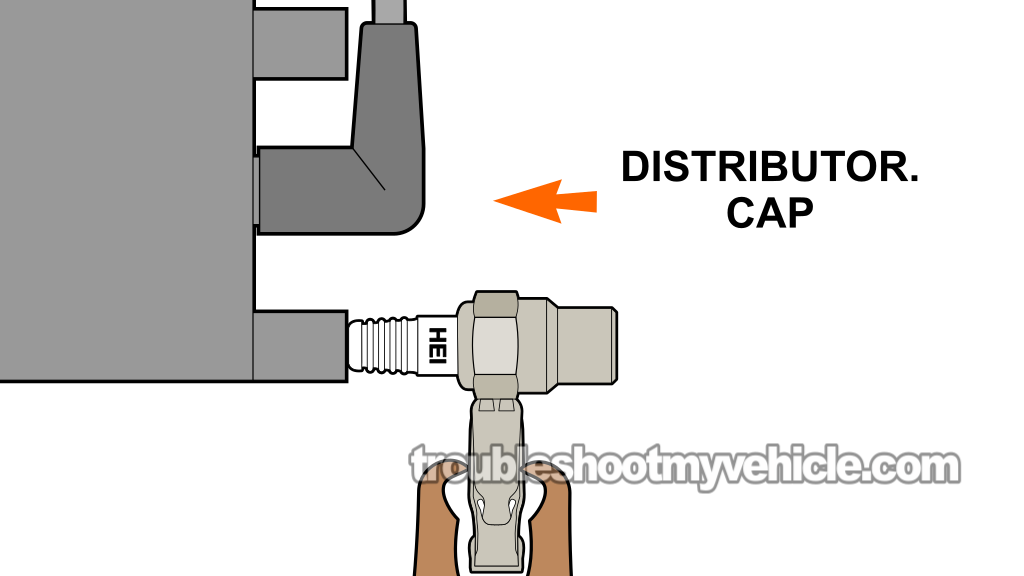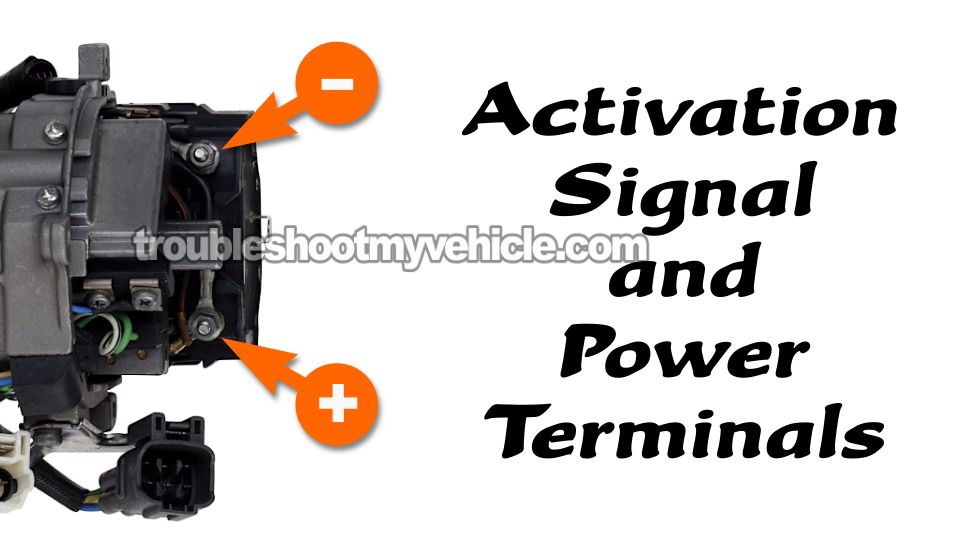TEST 3: Checking The Distributor Cap For Spark

When the spark plug wires aren't firing spark, it's usually because of one of two things:
- Worn-out spark plug wire: If the wire's old or damaged, it can't carry spark to the spark plug anymore.
- Faulty distributor cap: Carbon tracks or corrosion on the metal terminal inside the distributor cap tower can block the spark from reaching the spark plug wire.
To figure out what's wrong, we'll do a quick spark test on the distributor cap tower(s) connected to the non-sparking spark plug wire(s). If multiple wires aren't sparking, we'll test them one at a time.
Here's what the results will tell us:
- If the distributor cap tower sparks: The non-sparking spark plug wire is the problem.
- If there's no spark: The issue lies with the distributor cap tower itself.
Alright, let's get to it:
- 1
Double-check that all spark plug wires are connected to their spark plugs if any were unplugged.
- 2
Pull the spark plug wire off the distributor cap tower if it didn't spark.
NOTE: If more than one wire isn't sparking, test them one by one. For now, disconnect just this one —we'll move on to the next in Step 8. - 3
Insert the spark tester directly into the distributor cap tower.
- 4
Use a battery jump-start cable to Ground the spark tester by connecting it to the battery's negative (-) terminal.
NOTE: The jump-start cable also helps hold the spark tester in place inside the distributor tower. - 5
Have someone crank the engine.
CAUTION: The engine might start during this test. Be careful and take all safety precautions. - 6
You'll get one of two results: Either there's a spark, or there isn't.
- 7
Take out the spark tester and reconnect the spark plug wire to its distributor tower.
- 8
Repeat this process for any other distributor cap towers that connect to non-sparking spark plug wires from TEST 1.
Let's interpret your test result:
CASE 1: The spark tester sparked while inserted in the distributor cap tower. That's exactly what we wanna see.
This confirms the distributor cap tower is working fine, so the issue is with the non-sparking spark plug wire. Go ahead and replace all the spark plug wires as a set.
CASE 2: The spark tester DID NOT fire while inserted in the distributor cap tower. That means the distributor cap is faulty.
Swap out both the distributor cap and rotor, then run TEST 1 again to check the spark plug wires that weren't sparking.
TEST 4: Making Sure The Ignition Coil Is Getting Power

So far, your tests have confirmed that:
- None of the four spark plug wires fired spark (TEST 1).
- The ignition coil isn't sparking either (TEST 2).
Now, let's find out if the ignition coil is getting 10-12 Volts DC when you turn the key to the ON position.
To do that, we're gonna check the voltage directly at the ignition coil's (+) terminal (see the image above).
Here's what you need to do:
- 1
Turn the key to ON, but don't crank the engine.
- 2
If the distributor cap is still on, take it off.
- 3
Switch your multimeter to Volts DC mode.
- 4
Connect the black multimeter lead to the battery's negative (-) terminal.
- 5
Place the red multimeter lead on the ignition coil's (+) terminal.
- 6
Your multimeter should show a reading between 10 and 12 Volts DC.
Let's break down what your test results mean:
CASE 1: The multimeter shows 10 to 12 Volts DC. That's exactly what we wanna see.
Next up, we gotta check if the ignition coil is receiving its activation signal. Go to: TEST 5: Making Sure The Ignition Coil Is Getting Its Activation Signal.
CASE 2: The multimeter DIDN'T show 10 to 12 Volts DC. This usually means the ignition switch isn't sending power to the ignition coil.
In this tutorial, I don't cover troubleshooting a missing voltage issue, but you'll need to track down what's causing it. Once the ignition coil gets power again, it should start sparking.
TEST 5: Making Sure The Ignition Coil Is Getting Its Activation Signal

So far, your tests have confirmed:
- None of the four spark plug wires are firing (TEST 1).
- No spark is coming from the ignition coil tower (TEST 2).
- The ignition coil is receiving 10 to 12 Volts (TEST 4).
Now it's time for the final ignition coil check —checking for the presence of the ignition coil's activation signal (which is generated by the igniter).
To check for this signal, we're gonna use a 12-volt automotive test light and probe the (-) terminal on the ignition coil (see image above).
Don't have a 12-volt test light? Here's the one I recommend: Lisle 28400 Heavy Duty 12 Volt Test Light (at: amazon.com).
IMPORTANT: The igniter's has to stay connected to its electrical connector for this test to work.
These are the test steps:
- 1
Attach the 12V test light's alligator clip to the battery's positive (+) terminal.
- 2
Place the test light's metal probe on the ignition coil's (-) terminal.
NOTE: Keep the probe in place while performing the next step. - 3
Have someone crank the engine while you keep an eye on the 12V test light.
- 4
As the engine turns over, the 12V test light should blink ON and OFF repeatedly.
Let's break down what your test results mean:
CASE 1: The 12V test light flashed ON and OFF. That's the result we wanna see —it confirms the igniter is working and sending the activation signal to the ignition coil.
If you've checked off all of these:
- All four spark plug wires are NOT sparking (TEST 1).
- The ignition coil tower is NOT sparking (TEST 2).
- The ignition coil is receiving 10-12 Volts (TEST 4).
- The ignition coil is getting its activation signal (this test).
Then the ignition coil is bad and needs to be replaced.
CASE 2: The 12V test light DIDN'T flash ON and OFF. That means the ignition coil isn't sparking because the igniter isn't sending an activation signal.
The igniter's job is to generate and deliver that signal. Your next move? Test the igniter (ignition control module):
More 1.8L Toyota Corolla Tutorials
You can find a complete list of 1.8L Toyota Corolla tutorials and wiring diagrams in this index:
Here's a sample of the tutorials you'll find there:
- How To Test The Throttle Position Sensor (1993-1997 1.8L Toyota Corolla).
- How To Test The Fuel Injectors (1993-1997 1.8L Toyota Corolla).
- How To Test Engine Compression (1993-2008 1.8L Toyota Corolla).
- How To Test For A Blown Head Gasket (1993-2008 1.8L Toyota Corolla).

If this info saved the day, buy me a beer!

